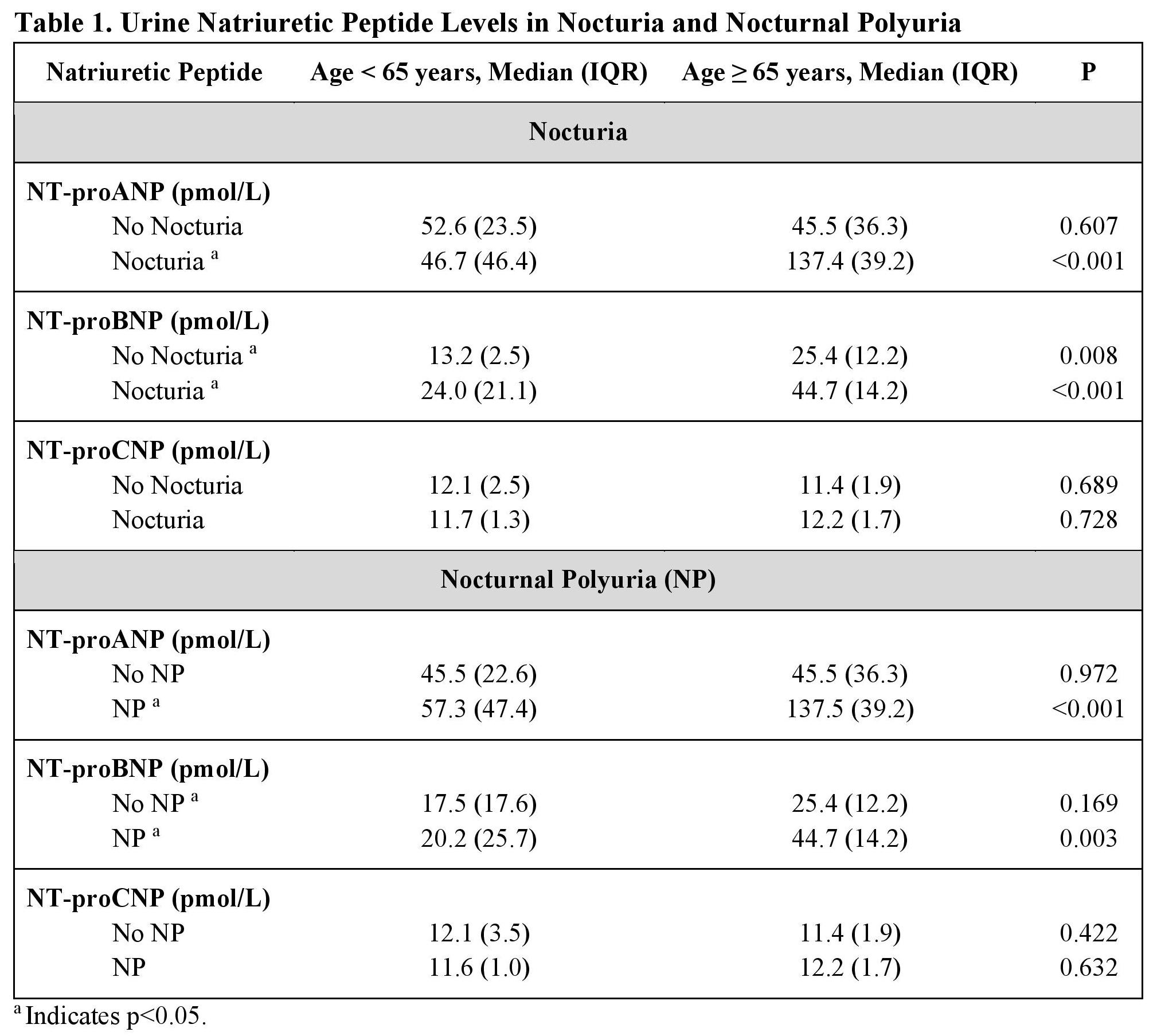Back
Poster, Podium & Video Sessions
Best Poster Award
MP18: Urodynamics/Lower Urinary Tract Dysfunction/Female Pelvic Medicine: Non-neurogenic Voiding Dysfunction I
MP18-01: The Effect of Aging on Urine Natriuretic Peptides in Nocturia and Nocturnal Polyuria
Friday, May 13, 2022
4:30 PM – 5:45 PM
Location: Room 222
Lakshay Khosla*, Joseph U. Boroda, Joshua Salama, Brooklyn, NY, Syed N. Rahman, New Haven, CT, Danielle J. Gordon, Brooklyn, NY, Matthew W. Moy, Westlake, OH, Yonatan Akivis, Alla Akivis, Jason M. Lazar, Jeffrey P. Weiss, Brooklyn, NY, Lori A. Birder, Pittsburgh, PA

Lakshay Khosla
SUNY Downstate Health Sciences University
Poster Presenter(s)
Introduction: Hormones involved in water homeostasis may impact the pathophysiology of age-related nocturia and nocturnal polyuria (NP). The purpose of this study was to analyze the effect of aging on urine natriuretic peptides in nocturia and NP.
Methods: Patients aged =18 years were recruited from 2019 to 2021 to complete bladder diaries for assessment of nocturia, defined as =2 nighttime voids, and NP, defined as nocturnal urine volume divided by 24-hour urine volume, or NP index (NPi), >0.33. Patients were excluded if they had characteristics that influence nocturia. They were divided into subgroups of <65 years old and =65 years old. Urine samples were analyzed for natriuretic peptide fragments (NT-proANP, NT-proBNP, and NT-proCNP). The Kruskal-Wallis H and Mann-Whitney U tests were used to compare patients stratified by status of nocturia/NP and age subgroups. Spearman’s rank order correlation was used to analyze correlations between NPi and urine natriuretic peptides.
Results: Compared to patients without nocturia (n=15; median ± IQR, 64.0 ± 13.8 years), those with nocturia (n=36; 68.0 ± 8.0 years) had significantly higher urine NT-proANP (86.0 vs 50.2 pmol/L, p=0.012) and NT-proBNP (33.1 vs 17.9 pmol/L, p=0.017), but showed no differences in NT-proCNP (11.4 vs 11.8 pmol/L, p=0.702). Patients with NP (n=30) had higher NT-proANP (96.2 vs 45.5 pmol/L, p<0.001) and NT-proBNP (34.9 vs 20.2 pmol/L, p=0.014), but showed no differences in NT-proCNP (11.8 vs 11.7, p=0.962) compared to those without NP (n=21). Compared to patients <65 years old with nocturia or NP, patients =65 years old with nocturia or NP had higher NT-proANP and NT-proBNP (Table 1). NPi positively correlated with NT-proANP (RS=0.416, p=0.002) and NT-proBNP (RS=0.328, p=0.019), but not with NT-proCNP (RS=-0.029, p=0.840).
Conclusions: Age-related nocturia may in part be explained by natriuretic peptides, since aged patients with nocturia had greater urine NT-proANP and NT-proBNP. To understand hormonal changes in the mechanisms of age-related nocturia, future work should look to analyze these effects in controlled settings and exploit the differences to determine potential treatment pathways for nocturia management.
Source of Funding: This study was supported by the Ferdinand C. Valentine Medical Student Research Grant in Urology from The New York Academy of Medicine awarded to LK.

Methods: Patients aged =18 years were recruited from 2019 to 2021 to complete bladder diaries for assessment of nocturia, defined as =2 nighttime voids, and NP, defined as nocturnal urine volume divided by 24-hour urine volume, or NP index (NPi), >0.33. Patients were excluded if they had characteristics that influence nocturia. They were divided into subgroups of <65 years old and =65 years old. Urine samples were analyzed for natriuretic peptide fragments (NT-proANP, NT-proBNP, and NT-proCNP). The Kruskal-Wallis H and Mann-Whitney U tests were used to compare patients stratified by status of nocturia/NP and age subgroups. Spearman’s rank order correlation was used to analyze correlations between NPi and urine natriuretic peptides.
Results: Compared to patients without nocturia (n=15; median ± IQR, 64.0 ± 13.8 years), those with nocturia (n=36; 68.0 ± 8.0 years) had significantly higher urine NT-proANP (86.0 vs 50.2 pmol/L, p=0.012) and NT-proBNP (33.1 vs 17.9 pmol/L, p=0.017), but showed no differences in NT-proCNP (11.4 vs 11.8 pmol/L, p=0.702). Patients with NP (n=30) had higher NT-proANP (96.2 vs 45.5 pmol/L, p<0.001) and NT-proBNP (34.9 vs 20.2 pmol/L, p=0.014), but showed no differences in NT-proCNP (11.8 vs 11.7, p=0.962) compared to those without NP (n=21). Compared to patients <65 years old with nocturia or NP, patients =65 years old with nocturia or NP had higher NT-proANP and NT-proBNP (Table 1). NPi positively correlated with NT-proANP (RS=0.416, p=0.002) and NT-proBNP (RS=0.328, p=0.019), but not with NT-proCNP (RS=-0.029, p=0.840).
Conclusions: Age-related nocturia may in part be explained by natriuretic peptides, since aged patients with nocturia had greater urine NT-proANP and NT-proBNP. To understand hormonal changes in the mechanisms of age-related nocturia, future work should look to analyze these effects in controlled settings and exploit the differences to determine potential treatment pathways for nocturia management.
Source of Funding: This study was supported by the Ferdinand C. Valentine Medical Student Research Grant in Urology from The New York Academy of Medicine awarded to LK.


.jpg)
.jpg)